European microphones from the past II
Ronette - Schumann - Summum - Metz
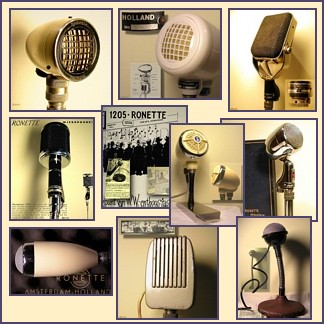
 statcounter since 2005-10-21:
statcounter since 2005-10-21:
|
|
|
|
 |
|
|
|
Last Updated: 2017-01-01 |
|
 My fellow Dutch collector of vintage microphones, Marco van der Hoeven, has published this wonderful
book with lots of info and excellent photos of many vintage microphones, all from his personal collection.
My fellow Dutch collector of vintage microphones, Marco van der Hoeven, has published this wonderful
book with lots of info and excellent photos of many vintage microphones, all from his personal collection.
The book is a must for anyone who loves vintage microphones, it is bound, hard cover and printed
on thick, high quality paper. Click on the picture or
here to go to his website and order the book !
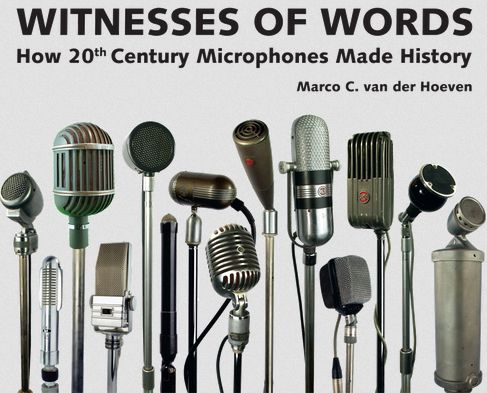
As far as I know they only produced crystal microphones (and microphone elements and pick-up elements). Around 1961 they introduced the unimpressive mc65 (mm65), a sign of the changing times. The introduction of transistor equipment and affordable dynamic microphones and pick-up elements ended this era of the crystal elements!

| Microphone: | Description: |
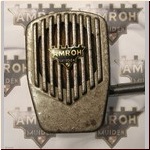

|
Amroh 46(?). * * * * A Dutch microphone from AMROH (AMerican RadiO House), maybe the number "46" is the year of production, although it looks more a like a tape recorder microphone and thus more likely to come from the 1950s. Inside is (not surprisingly) a Ronette element. |
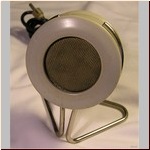
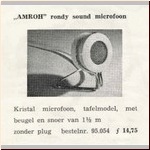
|
 Amroh Rondysound. * * * A Dutch microphone from AMROH (AMerican RadiO House), often used in combination with the Amroh taperecorders. |
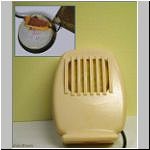
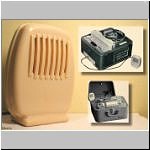
|
Lugavox. * * * * A cheap looking lightweight microphone. Nevertheless it has a Ronette element inside. As usual, the foam is almost gone (and I removed most of what remained to check the element). Possibly a microphone that came with the Belgian ACEC-Lugavox taperecorders (Ateliers de Constructions Electrique de Charleroi). |
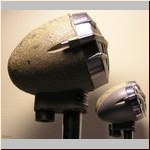
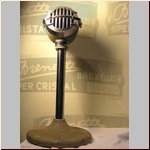
|
Brenette A434. * * * * * A jt-30 clone from Bruxelles (Brussel) Belgium. But the body is slightly bigger and it shows less refined craftsmanship. The overall condition is not that good and I have not managed to open this mic to see what kind of element is inside. A crystal element, that's for sure. |
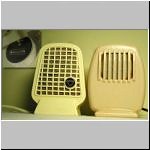
|
Lugavox. * * * * Another one, with another Amroh/Ronette 44 microphone on the left. |
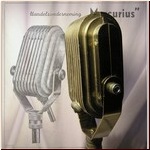
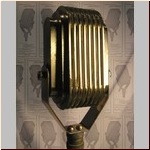
|
Mercurius * * * * * Great shape, but not an original design (see this Airline type "K" Ribbon microphone on Mike Schultz's "Reverse Time Page"). The same design was also used for an "Amerdyne" dynamic microphone. But this body has a (Ronette ZA) crystal element inside. This one is dated around 1947. The knurled knobs are missing, for the time being I have replaced them with some M6 screws. |
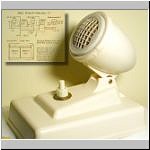
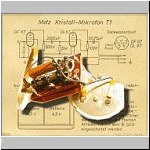 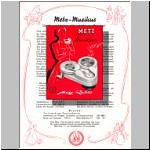
|
Metz T1. * * * * No. 935932. Metz Kristall-Mikrofon, this one probably came with a Metz (German) taperecorder, around 1952 ? (probably the "Metz Musikus", which was half a tape-recorder, it was driven by the motor of a phonograph). It is unusual since the head has some electronics, including two DF67 tubes. These are powered by two 4.5V batteries. The head is exactly like the head of the Ronette (B110) except the "Ronette - Holland" name is not present ( I think this was called the Ronette dbx head). |
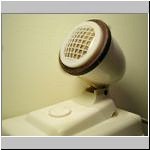

|
Metz T1. * * * * No. 939258. Another one, with a brown ring around the element. |
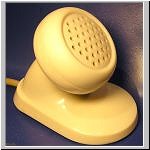
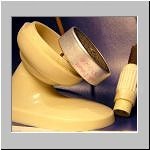
|
M.O.M. (?) * * * * Although there is a Tesla plug on this one, several people have indicated that this is probably not a Tesla microphone, but is from a M.O.M. tape recorder (Magyar Optikai Muvek - Hungary). It does have a Ronette Filtercell element inside. Cool design ! |
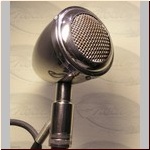
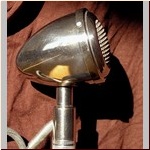
|
Neal. * * * * * Neal and Summum compete for the title of the least known microphones from the Netherlands. This Neal has no tag on the outside, so the previous owner assumed it was a Ronette, but the element has (barely visible) the Neal logo. Nothing else is known about it, not a serial number, nor the city where it was manufactured.  Although the name sounds english, I found out that it stands for "NEDERLANDSCH ELEKTRO ACOUSTISCH LABORATORIUM"
that was located in Den Haag and active around 1947.
Although the name sounds english, I found out that it stands for "NEDERLANDSCH ELEKTRO ACOUSTISCH LABORATORIUM"
that was located in Den Haag and active around 1947.
|
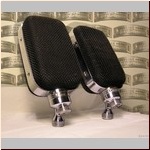
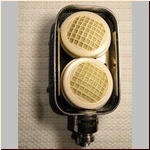
|
Procédés Herbay. * * * * * This is almost identical as the Ronette 640, except that these Herbays have the usual Ronette elements inside (cut-off to make them fit) whereas the 640 has smaller elements. |

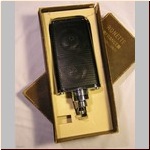
|
 Ronette 34. * * * * * Also a stereo model from France. Looks like this model was strictly for the french market. |
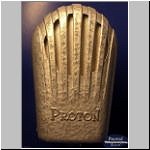
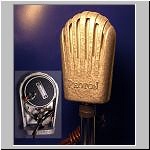
|
Proton * * * * The othertape recorder brand from Norway. It is not really clear to me if Proton and Radionette were one and the same company. Later the Radionette company merged with that other one, Tandberg. Here is a picture of the recorder complete with microphone. This one has a Ronette filtercel element, and dates from approx. 1954. |
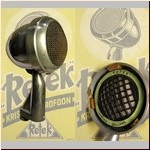
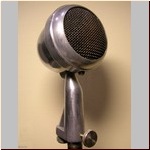
|
Retek 22 * * * * * Rare microphone by Retek in Arnhem (Netherlands). Not surprisingly this has a Ronette element. Probably from the late 1940's (I guess). |
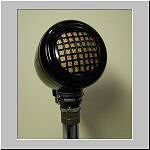
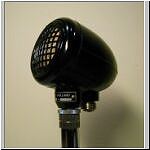
|
Ronette B110. * * No. 90624 These 'Ronette' microphones were made in Holland. This crystal bullet mike was also available in white. It is much much lighter (in weight) than e.g. the Astatic jt30. The b110 was introduced at least before 1952. micman-ronette erik's-ronette |
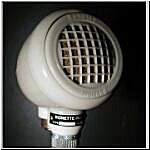
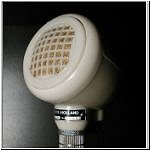 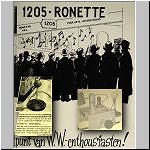
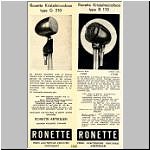 |
Ronette B110. * * No. 60950 the 'Ivory white' version. "The world-famous reporter microphone" "Most popular and widely used microphone among amateurs the world-over." "Case is of high quality Polopas, finished in polished ivory." "All Ronette piezo-electric products are guaranteed for tropical climate." Freq. range : 30 - 13KHz Output level: 1.1 mV/µ Bar at 1KHz and 5 megaohms. 1950's list price: $13.25 1947 list price: f 26.50 1952 list price: f 17.50 1961 list price: f 16.50 Polopas is a thermoset plastic, a brand name of urea-formaldehyde. Developed in 1929 it was often used in electrical products. |
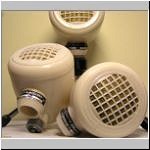
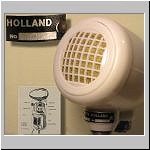
|
Ronette B110. * * No. 44495 No. 56334 No. 60950 All three white b110s, does this implicate that there were 60000 build ?
|
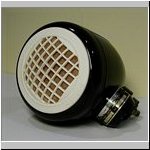
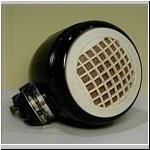
|
Ronette B110. * * No. 2611 "piezo electr. industrie" A black version with a white front. Seems like Ronette assembled the black and white parts in all possible combinations (I've also seen a white with black ring around the front grille). |
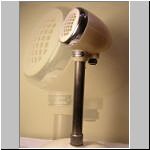
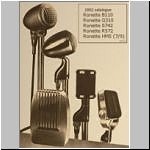
|
Ronette B110. * * * * * No. 49747 A rare version with a chrome ring. On the right, some models from a 1952 Amroh catalogue. |
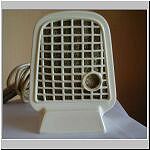
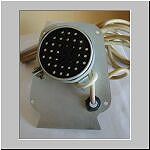
|
Ronette O44. * * A crystal microphone, with a Ronette DX-12 element. On the right side a picture of the inside of this microphone. The design is not completely original, I am 'shure' this was inspired by a more famous American model: micman-shcr81 ericorder "Has a metal loaded base, suitable as hand microphone. Semi-directional in characteristic." Freq. range : 30 - 13KHz Output level: 1.3 mV/µ Bar at 1KHz and 5 megaohms. 1950's list price: $10.50 |
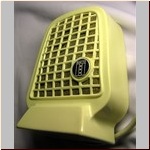
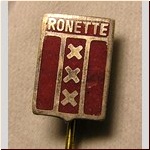
|
Ronette O44. * * * Finally a O44 that still has the original Ronette logo ! |
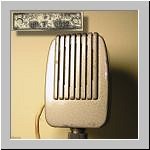
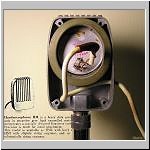
|
Ronette HM7. * * * Similar to the HM5 and HM9 (with slightly different characteristics). This one had no element, so I fitted it with a spare element from a junk model 44. 1952's list price: f 30.00 |
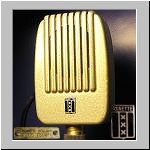
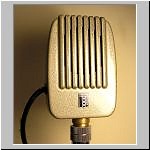
|
Ronette HM9. * * * See HM7. |
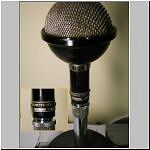
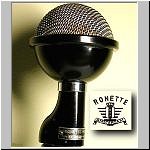
|
Ronette 088-u7 "Soundball". * * * This seems to be one of the rarer Ronette types. I do know that it was introduced in july 1952. The suffix '7' indicates that it had raise in sensitivity with 8db between 1 and 3 KHz. Also available was the 088/5 that had a straight characteristic. Maybe there was also a 088/9 type. Again, it made use of a filtercel element. Freq. range : - 7500Hz 1952's list price: f 37.50 |
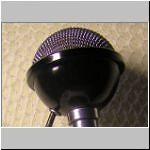
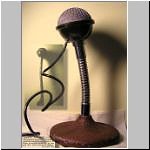
|
Ronette 088 "Soundball". * * * Nice one with stand. |
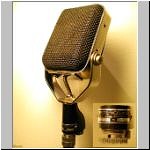
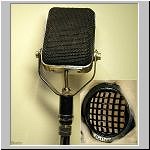 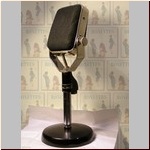

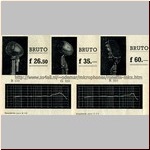
|
Ronette R510. * * * No. 1904 and No. 3528. The plastic ring around the (crystal) element is identical to that of the B-110. 1947 list price: f 60.00 1952 list price: f 49.50 The models B110,G310 and R510 are the oldest Ronette models, except possibly for the Ronette ZBD3. The oldest information that I have found dates from january 1947. |
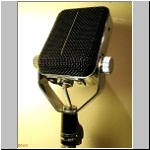
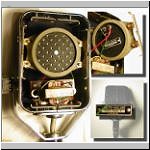
|
Ronette RFCL5. * * * No. 00690. Like the previous one, but this model has an output transformer inside. |
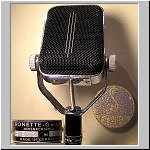
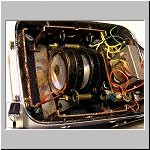
|
Ronette R572 L. (Merula) * * * A German Ronette, made (or distributed) by Schumann Hinsbeck. I think they later used the name Merula instead of Ronette. The box already has the Merula name on it. This one has a duo-cell inside, just like the model 742. The L means (very likely) low impendance, hence the transformer. |
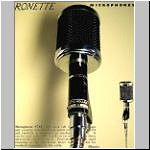
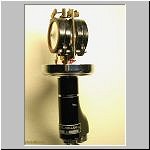 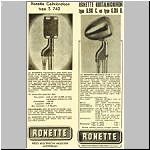
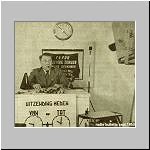 |
Ronette S742. * * * * No. 5347. According to micman the two elements are crystal elements and the microphone was advertised as the "Duo-Cell". "This twin cell balanced diaphragm unit provides omnidirectional sound pickup as with the R474 and similarly is insensitive to mechanical vibration. It can be used with cable lengths in excess of 50 ft. [...]" There is a similar Astatic model, the K-2, I wonder if there is any connection between these two ? Two advertisements from the Radio Bulletin 1950. The picture is from an experimental television broadcast in Groningen, I think the two mics are the Ronette s742 and on the desk a Philips 9561. |
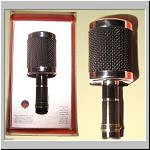

|
Ronette S742. * * * * No. 5002. 1961 list price: f 65.00 |
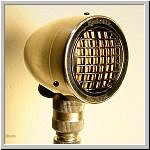
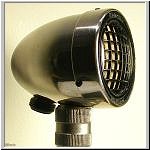
|
Ronette ZBD3. * * * * * Smaller than the B110, with a metal body. (I thought the model number was 803, but the '8' and '0' are really a 'B' and 'D'). Smaller than the B110, with a metal body. Around 1947 (maybe the oldest Ronette, because it has a different logo). It is never mentioned in later folders or advertisements, it could have been the forerunner of the B110 ? |

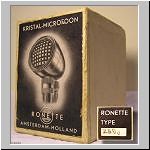
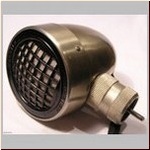
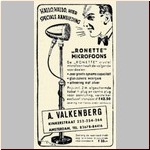
|
Ronette ZBD3. * * * * * Another one, not as nice as the previous one.  ... and another one ... NB. Only the first one is really original. This one has the
screw connector removed and the cable just enters the body there. Except for that, it is in good shape. ... and another one ... NB. Only the first one is really original. This one has the
screw connector removed and the cable just enters the body there. Except for that, it is in good shape.
|
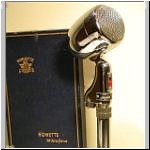
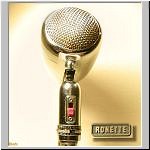
|
Ronette GS210 "wide range". * * * No L7. This is a 'German' Ronette (see the box) from Hinsbeck. This mic is in excellent condition. It looks very much like the model G310, this one looks too young to be 54 years old ! The filtercel FC7 element inside is still working. Freq. range : 30- 7500Hz 1952's list price: f 38.00 |
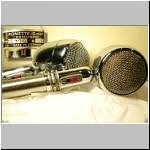
 |
Ronette GS210 "wide range". * * * No 5. Almost identical, except for the FC5 filtercel element. |
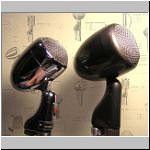
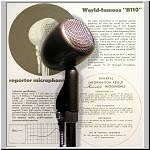 |
Ronette G310. * * * * Moulded head, this model is slightly bulkier than the model 210 and probably a few years older as well (introduced in or before 1949). The picture shows the 210 and 310 next to each other. Freq. range : 30 - 13KHz Output level: 2.5 mV/µ Bar. |
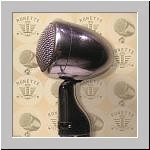
 |
Ronette G310. * * * * A chrome version of the Ronette G310. |
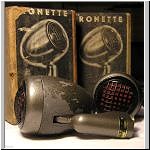
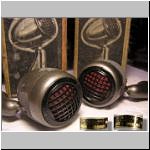 |
Ronette G310. * * * * * No. 2088. No. 2576. Probably 1948. These two Ronettes must be the earliest models. They don't have the metal grill, but have the default plastic front. These two are never used and come with the original boxes. Unfortunately, the paint didn't survive too well. The paintwork, or what is left of, is too delicate so they immediately went back into their boxes after these pictures were taken. There is another clue why these were made before 1949. These mics came from a radio shop - Radio Rotrekl in Zlin - and they were 'rescued' by the owner in fear of the nationalisation. In 2005 his grandson unearthed these two brothers and the mics found their way to this Ronette family ! |
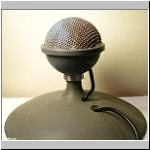
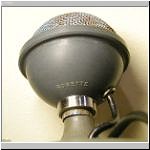
|
Ronette unknown model. * * * A ronette 'soundball'-like top on a lustraphone stand. The element is different from the ususal Ronette filtercel elements, this one is smaller and has the stamp ya8123 on it. |
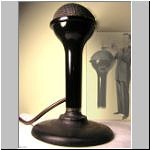
|
Ronette Coronation 53. * * * A variation on the 'soundball'. No doubt this model was targeted at the British market and was introduced in 1953 ! |
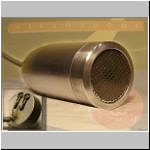
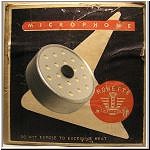
|
Ronette (unkown). * * * * This Ronette has the same (modern looking) small element as the MM65, this suggests it was from the sixties. It is almost identical to the Electro-Voice models 624 and 924 (lavalier mics). A similar box was used for other VM (Voice of Music) mics and Ronette did make some microphones for the VM company. |
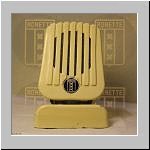
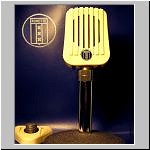
|
Schumann MKT1. * * * * * This model, a mixture of the O44 and HM-7 models is probably not a model that Ronette sold under their own name (despite the Ronette 'Amsterdam' logo !). But in Germany it was sold as Schumann MKT1. Freq. range : 30 - 13KHz Sensitivity : 4mV/µb at 1KHz 1956's list price: DM 38.50 As the O44 it has a DX-12 element and the body has the same problem that all O44 models seems to have, i.e. the plastic body has shrunk a little bit!  This microphone was also used for the tefifon, a precursor
of the cassetterecorder. Collectors pay big money for this microphone with the tefi-logo !! The Tefi microphone
seems much rarer than the tefifon itself, which is still easy to find on ebay.
This microphone was also used for the tefifon, a precursor
of the cassetterecorder. Collectors pay big money for this microphone with the tefi-logo !! The Tefi microphone
seems much rarer than the tefifon itself, which is still easy to find on ebay.
|
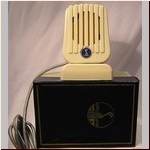
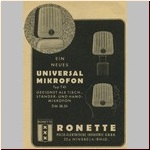
|
Schumann (Merula) MKT1. * * * * * NOS in box. 
|
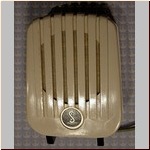
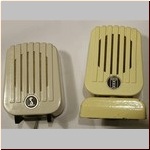
|
Schumann MKT1. * * * * * Another one, this time with the original F&H Schumann logo. Originally, this mic came with a Belgian reel-to-reel recorder. |
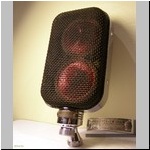
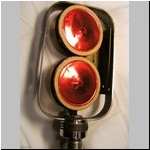
|
Ronette 640 (?). * * * * * A stereo model, or maybe 'dual-mono' would be a better description. The name tag says 'Ronette - France', the rest of the tag is unreadable, but the only time I have seen this mic before in a listing it was listed as a model 640. This model is (as far as I can tell) identical to a French microphone with the name 'Procédés Herbay', maybe this company had a similar relationship with Ronette as 'Schumann' in Germany ? |
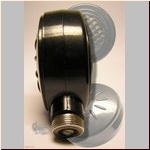

|
Ronette (?) (unknown). * * * * * This could be a genuine Ronette but it is also possible that this is a (french?) fabrication, built around the standard Ronette element. Here is an unknown French microphone, with the identical backplate. |
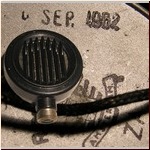
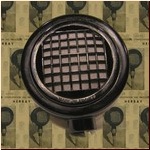
|
Herbay DBX Jr. * * * * * It seems that the official name for this (the one with the Ronette grill) model is Herbay DBX Jr (Societe d'exploitation des procedes Herbay). The other one is very similar, except for the grill. This one has a Ronette element with a stamped date of 1962. Here is an unknown French microphone, with the identical backplate. |
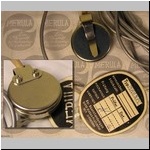
|
Merula MKK205. * * * * * A miniature lapel mic from 1960. |
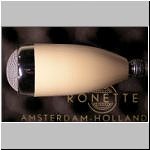
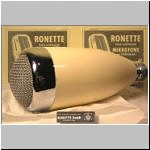
|
Ronette MKS2. * * * * A German model (the 'Amsterdam' logo shown in the picture does in fact not belong to this mic). Around 1962. Freq. range : 50 - 8KHz 1960's list price: DM 39.00 |
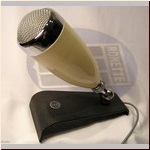
|
Ronette MKS2-6. * * * * Another one, also with the name Ronette and on the original stand with the Ronette logo. |
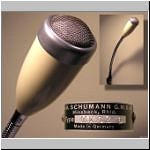
|
Schumann MKS2-6. * * * * The element suggests that is mic is from 1965 or later. The only difference between this one and the previous one is that the name 'Ronette' (at the base of the microphone) is replaced by the name 'Merula'. The chrome ring had lost a lot of it's chrome, so I repainted it with a silver-grey paint. |
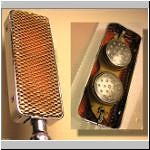
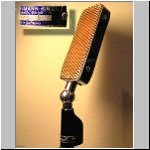
|
Schumann MKS5. * * * * This mic utilizes two (smaller than the usual Ronette elements) crystal elements. |

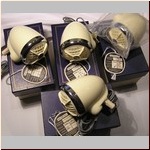
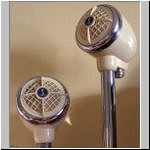
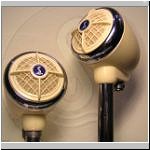
|
Schumann MKS4. * * * * * A rare model. Looks like a de-luxe model of a b110. Does not have a standard Ronette element. Around 1955. Freq. range : 50 - 12.5KHz Sensitivity : 4.5mV/µb at 1KHz 1956's list price: DM 29.50 This model was also available with a ceramic element (MCS4). Both types were available with two different elements KKM44/5 (for speech) and KKN44/6 (for music). I got some NOS (New Old Stock) MCS/MKS, all in their original Merula boxes and never used at all. The top 3 are all fitted with a ceramic element and have a production date of 1962. The bottom one has a production date of 1964 and has a crystal element. |
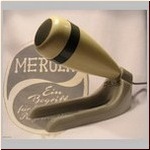

|
Schumann / Merula MCS5 or MKT5. * * * * * Also around 1955 and again available with a ceramic element (MCS6) but also with a dynamic element (MDS6) or with filter (MKS6 /F). Freq. range : 30 - 10KHz (or 50 - 7.5Khz with filter) Sensitivity : 1.2mV/µb at 1KHz 1956's list price: DM 46.00 The MKT 5 on the right is never used and in its original Merula box. Production year: 1961. The naming is a little bit inconsequent, since the MKS5 is a completely different type of microphone. |
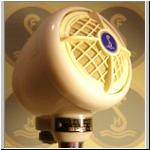
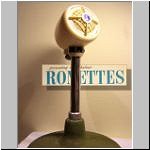
|
Ronette. This one has the same Schumann element but this time the body is the standard b110 shell. It could be the missing link but it is also possible it is a 'Pilt Down' model (maybe the original Ronette element died and was replaced later with this Schumann element ?). |
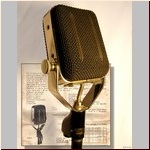
|
Ronette R474 * * * I finally found a R474. Not that this is the rarest of Ronettes (it certainly isn't) but I never had the opportunity to buy one for a reasonable price. This was the top of the bill of the all the Ronette microphones, inside it had four elements (cells). Sadly, this one isn't original inside, instead it has just a single (bigger) Ronette element. I guess this was replaced a long time ago. 1955 list price: (around) f 175.00 |
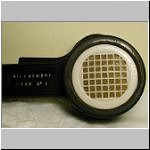

|
Hand Microphone No 3 with Ronette element. * * This is certainly not the original configuration, the "Hand Microphone No 3" is a well known army mic, from the WWII (I don't know the manufacturer). One of the previous owners replaced the original element with this Ronette element. |
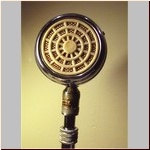
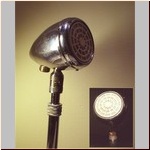
|
Summum Piëzo. * * * * * Very Rare ! Another Dutch microphone, never heard from this company from Groningen. I have not found any information on the internet about this mic (and the next one). This one has a Ronette DX-12 element inside. |
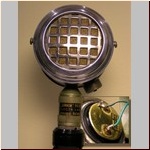
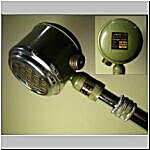
|
Summum Piëzo SM7. * * * * * Another one ... |
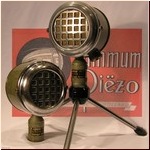
|
Summum Piëzo SM7. * * * * * No. 1508 Rare as these are, I found both summums in one week ! This one has a heavy duty steel body, unlike the previous summum model. |
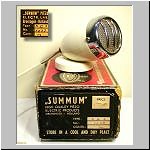

|
Summum Piëzo SB3. * * * * * No. 1033 "High Quality Piëzo Electric Products". |
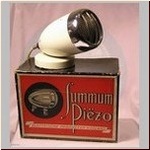
|
Summum Piëzo SB3. * * * * * No. 1205 Slightly less in quality, a few more scratches. The box belongs actually to a SB2, sadly I found the box without the original content. |
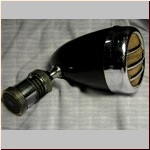

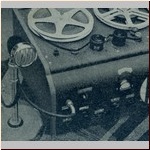
|
Irrgang SM310. * * * * * 'Irrgang's Microfoon Laboratorium Groningen (Holland)' The similarities with the Summum cannot be a coincidence. The Irrgang looks older, it dates probably from before the 1950's. Note the large connector, very uncommon !  A 1946 advertisement shows a "skymaster" SM310 microphone, maybe that was the official brand name.
A 1946 advertisement shows a "skymaster" SM310 microphone, maybe that was the official brand name.
|
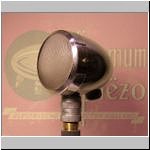
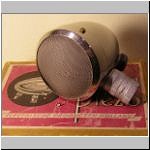
|
Summum Piëzo (unknown model) * * * * * Another ultra rare Summum microphone, with it's original box. |
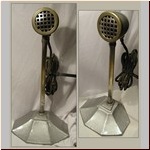
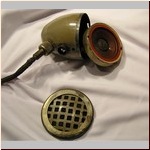
|
unknown model, possibly Summum * * * * * This is an unmarked and therefore unknown brand. But the grill suggests it could be a Summum. On the other hand, it looks like a dynamic microphone and as far as I know Summum only made microphones with crystal elements. The microphone was in a pretty raw state and almost certainly repainted at some time. So I tried to give it a new hammer paint look. |
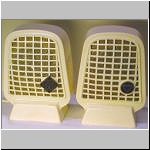
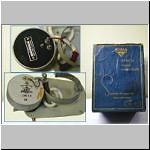
|
Telefunken dx12(?) - Amroh H. * * It seems that Telefunken not only used the production line of AKG, but also of the Dutch Ronette company. This one is a thinly disguised Ronette 44. The model on the right is labeled Amroh (a Dutch company that also made a tape recorder). The top element in the right picture is from the Amroh, it has the same 'filtercel' element as the Terta. The element seems to be in excellent shape (but obviously is not working in this state!). The bottom element (from the Telefunken) looks like it is older, it has stamped on it "Ronette - Amsterdam". |
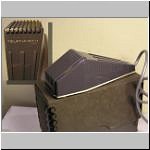

|
Telefunken mm65 (Ronette mm65). * * * * Another example of a Ronette microphone that is labeled as a Telefunken. A small crystal element, inside a cheap looking (and probably it was cheap!) plastic housing. Probably early 1960's. |
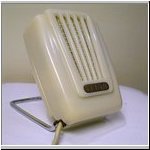

|
Terta. * * * * This hungarian microphone has a Ronette element inside (fc 5-7500-5 filtercel, whatever that means). The microphone is made of catalin (?), some kind of phenol-formaldehyde compound. See catalin radio for more info. |
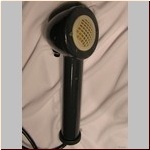
|
Unknown. * * * * * This microphone is likely to be of Dutch origin and it has a Ronette element. The connector on the other end of the cable is a Philips plug. It looks like it may have been used in a marine communication environment. |
This is my own totally un-scientific rating of the rarity of the different microphones. It is based on (a) what is offered on vending sites, (b) what is in other collections, (c) how much info can be found with Google and other search engines. A model gets only the top rating if I have never seen or heard of another one of this model in existence.
Of course, it does not necessarily mean that the rarest items are much more expensive than the more common models!
| Rarity: | Description: |
| * | Easy to find, e.g. at any time on ebay |
| * * | Not too hard to find |
| * * * | Not seen too often |
| * * * * | Pretty rare |
| * * * * * | Rare ! |
| * * * * * | Mega Super Ultra Rare ... at least that is what I think ! |
|
|||
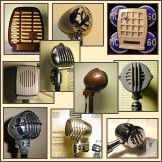 |
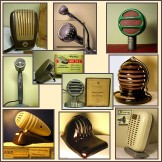 |
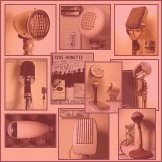 |
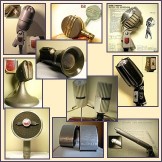 |